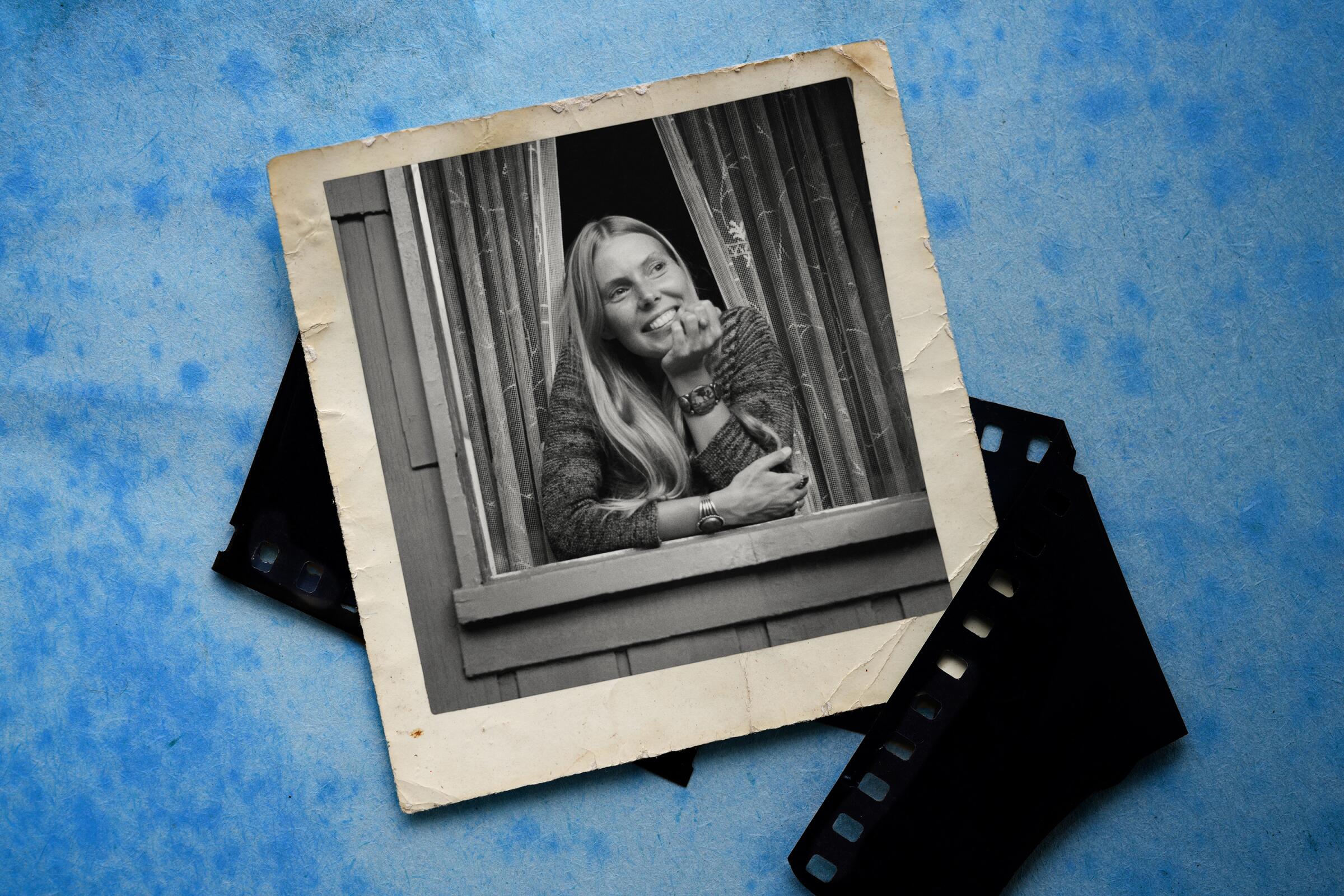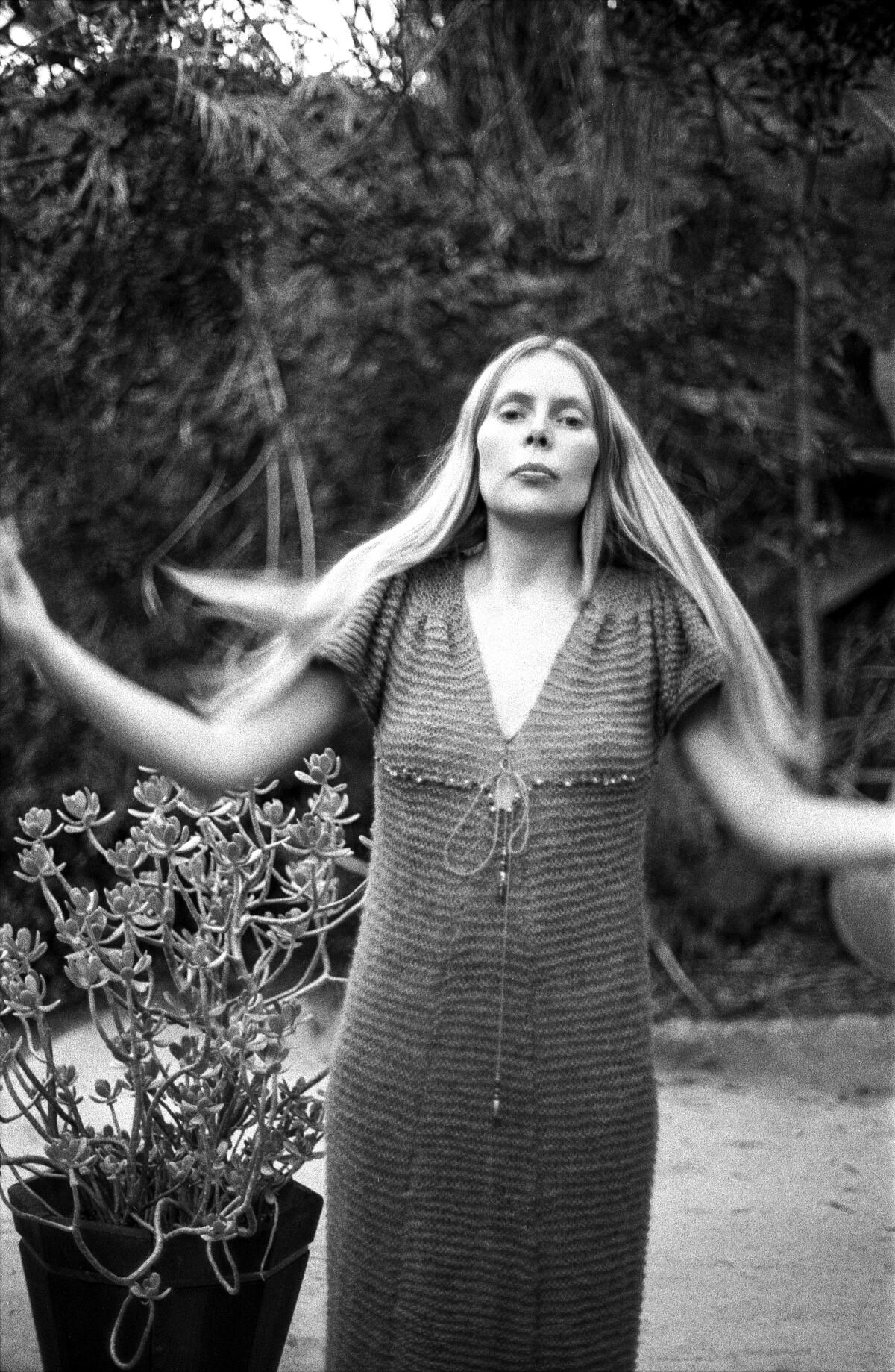The biggest entertainment stories
Get our big stories about Hollywood, film, television, music, arts, culture and more right in your inbox as soon as they publish.
You may occasionally receive promotional content from the Los Angeles Times.

While the genius of Joni Mitchell is now a settled matter, when she first arrived in Los Angeles in 1967 there was only the idealized moniker “a girl with everything.”
This is how she was introduced to the Laurel Canyon beau monde via David Crosby, how she was remembered by Graham Nash in his 2013 memoir, and how she was regularly described in the earliest profiles of her. At the time, the male-dominated music press was still choosing between archetypes of who and what women artists could be: earth mama or angelic naif. “A girl with everything,” in turn, meant that Mitchell could sing, play an instrument, write a song and, of course, that she was blond and thin and pretty. Such was the world of gendered low expectations that Joni Mitchell’s career was born into.
Yet by the dawn of the 1970s, the true scope of Mitchell’s “everything” was remarkably vast by any measure. She had full contractual, artistic control of her albums and helped blaze that path for others, including Neil Young. She controlled her own music publishing, which reportedly netted her more than a half-million dollars in royalties (roughly $3.5 million today) before she’d even put her 1971 masterwork “Blue” to tape. Mitchell owned a car and multiple homes at a time when a woman couldn’t even legally get a credit card in her own name. She was an unmarried woman who traveled the world on her own and lived as she wished. She canceled tours she didn’t want to do and disappeared to her coastal Canadian hermitage to read, recuperate, compose songs and be alone. She was a celebrated woman who lived with rare freedom.
On “Blue”’s “All I Want,” Joni Mitchell asked “Looking for something, what can it be?” The answer was Joni Mitchell.
At first, though, her music was a means of survival. She’d initially set up her own publishing while still a performer on the regional folk-coffeehouse circuit in the mid-’60s, as she needed to earn money in order to leave her marriage. Joni Anderson met and quickly married Chuck Mitchell mere weeks after she’d given birth to a daughter whose father had long since skipped town. As a struggling young singer living off one meager gig at a time, Mitchell could barely afford to feed herself, and was without resources to care for her daughter, so she had put her in foster care. She would come to quickly regret both the marriage and her daughter’s adoption. Bereft, songs poured out of her and she committed herself to being a songwriter, a composer.
The “everything” Joni Mitchell became was in service of herself and her art, of her total independence. She wrote her own songs, produced her own albums, conceived their covers, art directed her own photos and decided on her own image and presentation at every turn. Mitchell was sovereign.

Still, such freedom had been possible only because Crosby, then fresh out of the Byrds, ushered her in the door at Reprise Records and insisted he’d produce her debut. Later, they’d both acknowledge their strategy was a ploy to get her as long a creative leash as possible, something even a burgeoning genius like Mitchell couldn’t have won otherwise. “Without David’s protection the record company might have set some kind of producer on me who’d have tried to turn an apple into an orange,” Mitchell explained. “I don’t think I would have survived that.” As time went on, Mitchell merited the attention and allegiance of other powerful men: subsequent boyfriends Nash, Jackson Browne and James Taylor; and her star-making agent David Geffen. For the music press, her proximity to these major players was a signal of her artistic worth.
Mitchell’s understanding of herself as an artist was often at odds with how the music industry and press saw her, and she was rightfully insulted by the way critics circumscribed her ambition with gendered limits. In early interviews she refused the constant comparisons between her and Joan Baez, her and Judy Collins, pointing out how she’d since moved beyond folk. “What I was doing was not really folk music, it just looked like it because I was a girl with a guitar,” she’d say later. The only contemporaries whose work she publicly respected and praised were Bob Dylan and Leonard Cohen, but she had different aims. Unlike most of her peers she wasn’t trying to ape Dylan but rather be like her hero, Miles Davis, and make her voice as dynamic as his trumpet playing. She wanted to be a composer at the very vanguard of music, braving new avenues in sounds, song, structure, tunings.
On “Blue”’s “All I Want,” Joni Mitchell asked “Looking for something, what can it be?” The answer was Joni Mitchell.
By the time Mitchell returned to A&M Studios in Hollywood to record “Blue” in early 1971, her public profile had soared. Several of Mitchell’s songs had become contemporary standards, with Judy Collins scoring a top-10 hit and a Grammy in 1968 with her version of “Both Sides Now.” Twenty-plus artists would record “Both Sides Now,” including Neil Diamond, Frank Sinatra and Leonard Nimoy, all before Mitchell would release it herself on her second album, “Clouds.” Her songs “Big Yellow Taxi” and “The Circle Game” were now hippie sing-alongs. Crosby, Stills, Nash & Young had scored a generation-defining anthem with their cover of her song “Woodstock,” shortly before it would be released on her third album, “Ladies of the Canyon.” But with “Blue,” Mitchell ensured there’d be no mistaking her work for anyone else’s. “Blue” is where her talent and ambition start to come into sync, the point where Joni Mitchell becomes Joni Mitchell.

It’s not just that “Blue” was a beautiful album; it captured the zeitgeist with its poignant portrayal of disillusionment. “Reading the news and it sure looks bad / They won’t give peace a chance / That was just a dream some of us had,” Mitchell sings in the opening verse to “California.” At the time she was writing these songs, the Edenic dream of the Woodstock generation was confronting grim realities: the reinstatement of the draft, the Kent State shootings, the revelations of the My Lai Massacre and COINTELPRO campaigns against Black activists, the dawn of the Weathermen. The way Mitchell renders “just a dream some of us had” makes clear she’s a world away from the wonder of the “carousel of life” she sang about on “The Circle Game” just a few years before. The dark tenor of “Blue” often is ascribed to Mitchell’s depression in the wake of successive breakups with Nash and Taylor, but the album’s tone of longing intertwines with mourning. “Little Green” is the lost-love ode to the daughter she had to give up. “The Last Time I Saw Richard” and title track reflect the ebbing hope of the peace-love dream and growing cynicism, not just for Mitchell personally but for her generation.
Youth culture’s liberationist ideals were steadily making their way into the mainstream at the dawn of the ’70s, aided by the growing momentum of second-wave feminists and the campaign for the Equal Rights Amendment, the birth of the American Indian Movement, the Black Panthers and the broader Black Liberation movement, and Dolores Huerta and the UFW campaigns. Women were pushing back on prescriptive gender roles and fighting legal and cultural restrictions on their bodily autonomy and freedom. Women expressing themselves fully, putting their desires or comfort first, was new and exciting ground.
“Blue’s” yearning for freedom and continual self-discovery paralleled second-wave aims. Joni Mitchell affirmed possibility within the lives of her listeners. Those who were finding inspiration, or a foothold, in feminism were dreaming, questioning, self-actualizing in the same ways Joni Mitchell was within “Blue.” Women in her songs had names, jobs, hobbies, non-romantic needs. While Mitchell might not have wanted to be the glamorous bard of women’s rising consciousness, with “Blue” she was just that.
We asked 10 of our favorite artists to each choose one track from Joni Mitchell’s ‘Blue’ and describe what makes the song and artist so indelible.
“Blue” raised the bar heaven-high on first-person confessional songwriting. Yet some bristled at the vulnerability of “Blue,” or perhaps at having to listen to a woman sing about what she thinks, what she wants, how she feels for the better part of an hour. “‘River’ is an extended mea culpa that reeks of self-pity,” Timothy Crouse wrote in Rolling Stone. “I suspect,” Don Heckman surmised in the New York Times, “this will be the most disliked of Miss Mitchell’s recordings, despite the fact that it attempts more and makes greater demands on her talent than any of the others.” Canadian magazine Maclean’s offered guarded praise: “She has always had a unique sense of melody, but she used to play word games; now, apparently on a romantic bummer, she wants to tell us about herself.”
That Joni Mitchell left little out of the audience’s view is the defining gift of “Blue.” Her candor made women feel seen, and communicated that their real lives were valuable material for their art; they could be more than muses. Like Mitchell herself, they could be complicated musical geniuses, poetic virtuosos. Those revelations are the album’s legacy, allowing listeners and artists to bring their whole selves into the music, again and again.
Jessica Hopper is the author of “The First Collection of Criticism by a Living Female Rock Critic” (MCD x FSG Originals). This piece was adapted, in part, from her forthcoming book, “No God but Herself: How Women Changed Music in 1975.”
The biggest entertainment stories
Get our big stories about Hollywood, film, television, music, arts, culture and more right in your inbox as soon as they publish.
You may occasionally receive promotional content from the Los Angeles Times.